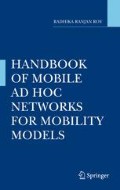Abstract
The group force mobility model that can take care of the environmental changes such as collision avoidance and congestion in the group mobility in terms of exerting forces is explained. We have described how the GFMM can simulate more realistic mobility adapting to an environment stimuli. In addition, the simulation results are compared between the GFMM and the RPGM.
Access this chapter
Tax calculation will be finalised at checkout
Purchases are for personal use only
References
Williams, S A and Huang, D (2006) A group force mobility model. Communications and Networking Simulation Symposium
Helbing, D et al (2000) Simulating dynamical features of escape panic. Nature 407.
Helbing, D et al (2002) Simulation of Pedestrian Crowds in Normal and Evacuation Situations. Springer, Berlin
Reynolds, C W (1999) Steering Behavior for Autonomous Characters. Game Developers Conference
Hong, X et al (1999) A Group Mobility Model for Ad-Hoc Wireless Networks. MSWiM
Perkins, C (1997) Ad-hoc On-demand Distance Vector Routing. MILCOM
Camp, T et al (2002) A Survey of Mobility Models for Ad Hoc Network research. WCWC
Bai, F (2003) IMPORTANT: A Framework to Systematically Analyze the Impact of Mobility on Performance of Routing Protocols for Ad Hoc Networks INFOCOM
Author information
Authors and Affiliations
Corresponding author
Rights and permissions
Copyright information
© 2011 Springer Science+Business Media, LLC
About this chapter
Cite this chapter
Roy, R.R. (2011). Group Force Mobility. In: Handbook of Mobile Ad Hoc Networks for Mobility Models. Springer, Boston, MA. https://doi.org/10.1007/978-1-4419-6050-4_29
Download citation
DOI: https://doi.org/10.1007/978-1-4419-6050-4_29
Published:
Publisher Name: Springer, Boston, MA
Print ISBN: 978-1-4419-6048-1
Online ISBN: 978-1-4419-6050-4
eBook Packages: Computer ScienceComputer Science (R0)

